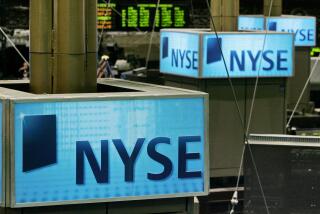‘Death Watch’ on Profits May Again Prove Premature
- Share via
Spectacular corporate earnings growth has underpinned the 1990s stock bull market all along. Which is why, at the beginning of every quarter, Wall Street now mounts a sort of “death watch” while awaiting the previous quarter’s earnings results: Will the numbers be so weak as to spell the certain end of stocks’ advance?
With first-quarter earnings reports due in the next few weeks, the backdrop isn’t encouraging. The computer business has definitely slowed, tainting the entire huge technology stock sector. Higher interest rates may have taken a toll on some financial firms. And many industrial and transportation companies’ results may have been hurt by complications from the frigid winter and from the just-settled General Motors strike.
For the record:
12:00 a.m. March 28, 1996 For the Record
Los Angeles Times Thursday March 28, 1996 Home Edition Business Part D Page 2 Financial Desk 1 inches; 21 words Type of Material: Correction
S&P; 500--Earnings for the Standard & Poor’s 500 companies grew 79% between 1992 and 1995. The growth rate was misstated in Market Beat on Wednesday.
No wonder that Wall Street analysts have on balance been lowering earnings estimates for the companies they follow. New York-based IBES, which tracks analysts’ estimates, says 1,151 individual company estimates for 1996 were cut over the past month, while 734 were raised.
Another earnings-tracker, Zacks Investment Research in Chicago, says the net result of analysts’ growing pessimism is that operating earnings (that is, profits before deducting any one-time write-offs) for the Standard & Poor’s index of 500 blue-chip companies are expected to grow just 4% in the first quarter compared with first-quarter 1995 profits.
*
That’s a far cry from the double-digit earnings growth that investors have been used to since 1992. The S&P; companies in 1995 earned 44% more than in 1992. Not coincidentally, the S&P; index itself jumped 48% over that time period.
Moreover, growth in operating earnings in the first quarter may mask another decline in true, bottom-line earnings after one-time write-offs. Some analysts argue that operating earnings are misleading because restructuring write-offs are becoming every-time occurrences for some firms, for which there are real financial consequences. Counting write-offs, S&P; earnings overall have been edging lower since second-quarter 1995.
Hence, to Wall Street’s gloomiest bears the stock market is like the roadrunner-chasing cartoon character Wile E. Coyote, who keeps running even when he’s far over the cliff. Once he looks down, of course, his legs stop, and it’s straight to the bottom of the canyon.
Salomon Bros. investment strategist David Shulman, while not a raging bear, believes that we have at least reached a point where disappointing earnings reports and rising fear that Corporate America’s profit margins have peaked in this business cycle could finally trigger as much as a 10% pullback in stock prices this spring.
But investors have heard that line many times. Before getting too caught up in the earnings death watch, three points are worth considering.
First, remember that it’s a big stock market out there. The S&P; index’s earnings are a convenient benchmark, but plenty of companies are thriving when the aggregate S&P; figure says otherwise.
Second, the surprise of the first quarter may be that the U.S. economy grew faster than expected. Remember the government’s shocking report about massive job creation in February? Or the surge in February housing starts? At a minimum, we know the economy isn’t simply rolling over.
Third, the stock market typically doesn’t care what earnings were--only what they will be. “Yes, the first quarter will show very low single-digit earnings growth” for blue-chip companies as a group, says Abby J. Cohen, investment strategist at Goldman, Sachs & Co. in New York. “But this is not new news,” she argues. “The real story is what happens in the second half of the year.”
Cohen believes that economic growth will pick up enough in the second half to generate an 8% gain in full-year 1996 operating earnings for the S&P; companies as a whole. Even more important, she believes that economic growth will continue worldwide next year (i.e., no recession looms), producing a 10% S&P; earnings gain in 1997. With that backdrop the stock market can continue to rise, albeit modestly, she says.
Is Cohen too optimistic? Maybe. Certainly there is very little room for error, because at these heights stock prices would quickly appear grossly overvalued if the next significant move in corporate earnings is down rather than up.
But if you believe in a still-growing U.S. economy, and in a still-fervent devotion on the part of corporate managers to the bottom line, betting against corporate earnings growth in 1996 and 1997 may be a foolish wager.
(BEGIN TEXT OF INFOBOX / INFOGRAPHIC)
End of Boom?
Corporate earnings have been falling since the second quarter of 1995, although they remain sharply above levels of a few years ago. Reported results “per share” for the Standard & Poor’s 500-share index:
Source: Standard & Poor’s Corp.
More to Read
Inside the business of entertainment
The Wide Shot brings you news, analysis and insights on everything from streaming wars to production — and what it all means for the future.
You may occasionally receive promotional content from the Los Angeles Times.










